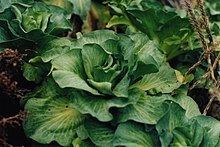Scientific name Pringlea antiscorbutica Rank Species | Higher classification Pringlea | |
 | ||
Genus PringleaT.Anderson ex Hook.f. Similar Pringlea antiscorbutica, Cabbage family, Streptanthella | ||
Pringlea antiscorbutica, commonly known as Kerguelen cabbage, is a flowering plant and the sole member of the monotypic genus Pringlea in the cabbage family, Brassicaceae. Its common name comes from the archipelago of its discovery, the Kerguelen Islands, and its generic name derives from Sir John Pringle, President of the Royal Society at the time of its discovery by Captain James Cook's Surgeon, William Anderson in 1776.
Contents
Distribution
The species grows on the remote Heard Island and McDonald Islands, Crozet, Prince Edward and Kerguelen Islands. The ancestor of P. antiscorbutica probably migrated from South America some five million years ago.
Ecology
The home islands of Kerguelen cabbage are at roughly 50° South Latitude and constantly buffeted by strong winds. This climatic feature is unfavorable for wind pollination, excepting on infrequent mild days, and this plus the absence of potential insect pollinators explains why the Kerguelen cabbage is self-pollinating. The plants grow to a diameter of about 50 cm in around four years, and flower for the first time in their third or forth year. At the mature stage, this species exhibits several adaptations linked to cold tolerance such as high polyamine levels.
Uses
The plant is edible, containing high levels of potassium. Its leaves contain a vitamin C-rich oil, a fact which, in the days of sailing ships, made it very attractive to sailors suffering from scurvy, hence the species name, which means "against scurvy" in Latin. It was essential to the diets of the whalers on Kerguelen when pork, beef, or seal meat was used up. In May 1840, botanist J.D. Hooker was the first to make a technical analysis of the plant, and to assign the Latin name. Hooker also reported having eaten some soup that had been made with Kerguelen cabbage, and described the raw leaves as tasting like cress, the boiled leaves as tasting like "stale" (i.e., dried-out) cabbage, and the root as tasting like horseradish.
Conservation
The micropezid fly species Calycopteryx mosleyi is associated with this plant. Both are endangered by invasive rabbits which feed on the cabbage.
